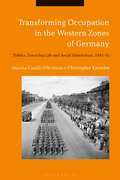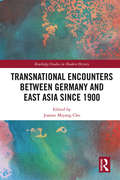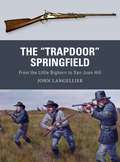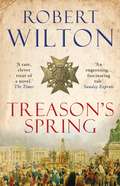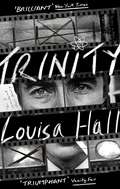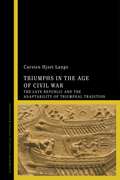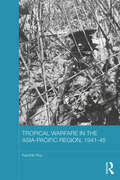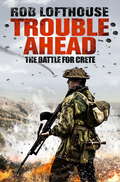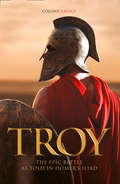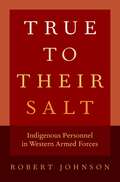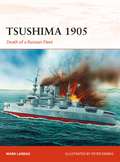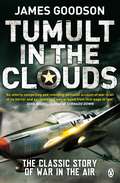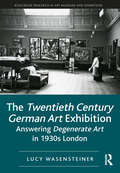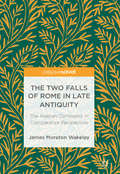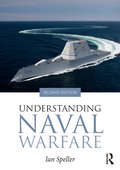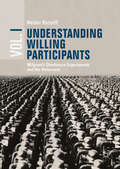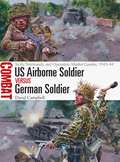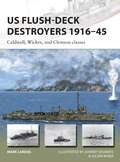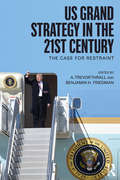- Table View
- List View
Transforming Occupation in the Western Zones of Germany: Politics, Everyday Life and Social Interactions, 1945-55
by Camilo Erlichman Christopher KnowlesTransforming Occupation in the Western Zones of Germany provides an in-depth transnational study of power politics, daily life, and social interactions in the Western Zones of occupied Germany during the aftermath of the Second World War. Combining a history from below with a top-down perspective, the volume explores the origins, impacts, and legacies of the occupations of the western zones of Germany by the United States, Britain and France, examining complex yet topical issues that often arise as a consequence of war including regime change, transitional justice, everyday life under occupation, the role of intermediaries, and the multifaceted relationship between occupiers and occupied. Adopting a novel set of approaches that puts questions of power, social relations, gender, race, and the environment centre stage, it moves beyond existing narratives to place the occupation within a broader framework of continuity and change in post-war western Europe. Incorporating essays from 16 international scholars, this volume provides a substantial contribution to the emerging fields of occupation studies and the comparative history of post-war Europe.
Transnational Encounters between Germany and East Asia since 1900 (Routledge Studies in Modern History)
by Joanne Miyang ChoThis volume contributes to an emerging field of Asian German Studies by bringing together cutting-edge scholarship from international scholars working in a variety of disciplines. The chapters survey transnational encounters between Germany and East Asia since 1900. By rejecting traditional dichotomies between the East and the West or the colonizer and the colonized, these essays highlight connectedness and hybridity. They show how closely Germany and East Asia cooperated and negotiated the challenges of modernity in a range of topics, such as politics, history, literature, religion, environment, architecture, sexology, migration, and sports.
Transnational Encounters between Germany and East Asia since 1900 (Routledge Studies in Modern History)
by Joanne Miyang ChoThis volume contributes to an emerging field of Asian German Studies by bringing together cutting-edge scholarship from international scholars working in a variety of disciplines. The chapters survey transnational encounters between Germany and East Asia since 1900. By rejecting traditional dichotomies between the East and the West or the colonizer and the colonized, these essays highlight connectedness and hybridity. They show how closely Germany and East Asia cooperated and negotiated the challenges of modernity in a range of topics, such as politics, history, literature, religion, environment, architecture, sexology, migration, and sports.
The "Trapdoor" Springfield: From the Little Bighorn to San Juan Hill (Weapon #62)
by Steve Noon John Langellier Alan GillilandIntended to replace the proliferation of different small arms fielded by US forces during the American Civil War, the “Trapdoor Springfield” was designed in 1865–66 by Erskine S. Allin. Using metallic cartridges, it could be loaded in a single action, increasing the number of shots per minute as much as fivefold. The new weapon quickly proved its worth in two separate incidents in August 1867: small groups of US soldiers and civilians armed with the trapdoor repulsed numerically superior Native American contingents. A simple and cost-effective weapon, it was used, along with its variants in every US conflict in the three decades after the Civil War, especially on the American frontier.Drawing upon first-hand accounts from US soldiers, their Native American opponents, and users such as buffalo hunters, this is the story of the “Trapdoor Springfield”, one of the defining weapons of the Indian Wars.
Treason's Spring: A sweeping historical epic for fans of CJ Sansom (Archives of Tyranny #4)
by Robert WiltonFrom the winner of the Historical Writers' Association/Goldsboro Crown Award for Historical Debut Fiction.'A rare, clever treat of a novel.' Antonia Senior, The Times1792: the blood begins to drip from the guillotine. The French Revolution is entering its most violent phase, and threatens all Europe with chaos. In the age of the mob, no individual is safe. The spies of England, France and Prussia are fighting their own war for survival and supremacy. Somewhere in Paris is a hidden trove of secrets that will reveal the treacheries of a whole continent.At the height of the madness a stranger arrives in Paris, to meet a man who has disappeared. Unknown and untrusted, he finds himself the centre of all conspiracy. When the world is changing forever, what must one man become to survive?Treason's Spring is a thrilling and meticulous panorama of Paris in the Revolution whose revelations transform our understanding of an era.
Trinity: Shortlisted for the Dylan Thomas Prize
by Louisa Hall'Brilliant . . . Hall has shaped a richly imagined, tremendously moving fictional work. Its genius is not to explain but to embody the science and politics that shaped Oppenheimer's life . . .The resulting quantum portrait feels both true and dazzlingly unfamiliar' New York Times J. Robert Oppenheimer - the father of the atomic bomb - was a brilliant scientist, a champion of liberal causes, and a complex and often contradictory character. In Louisa Hall's kaleidoscopic novel, seven fictional characters bear witness to his life. From a secret service agent who tailed him in San Francisco, to the young lover of a colleague in Los Alamos, to a woman fleeing McCarthyism who knew him on St. John, as these men and women fall into the orbit of a brilliant but mercurial mind at work, all consider his complicated legacy while also uncovering deep and often unsettling truths about their own lives.In Trinity, Louisa Hall has crafted an explosive story about what it means to truly know someone, and about the secrets we keep from the world and from ourselves.
Triumphs in the Age of Civil War: The Late Republic and the Adaptability of Triumphal Tradition
by Carsten Hjort LangeMany of the wars of the Late Republic were largely civil conflicts. There was, therefore, a tension between the traditional expectation that triumphs should be celebrated for victories over foreign enemies and the need of the great commanders to give full expression to their prestige and charisma, and to legitimize their power.Triumphs in the Age of Civil War rethinks the nature and the character of the phenomenon of civil war during the Late Republic. At the same time it focuses on a key feature of the Roman socio-political order, the triumph, and argues that a commander could in practice expect to triumph after a civil war victory if it could also be represented as being over a foreign enemy, even if the principal opponent was clearly Roman. Significantly, the civil aspect of the war did not have to be denied.Carsten Hjort Lange provides the first study to consider the Roman triumph during the age of civil war, and argues that the idea of civil war as "normal" reflects the way civil war permeated the politics and society of the Late Roman Republic.
Tropical Warfare in the Asia-Pacific Region, 1941-45 (Asian States and Empires)
by Kaushik RoyThis is the first book to provide a comprehensive overview of the land war during the Second World War in South-East Asia and the South and South-West Pacific. The extensive existing literature focuses on particular armies – Japanese, British, American, Australian or Indian – and/or on particular theatres – the Philippines, Papua New Guinea, Malaya or Burma. This book, on the contrary, argues that warfare in all the theatres was very similar, especially the difficulties of the undeveloped terrain, and that there was considerable interchange of ideas between the allied armies which enabled the spread of best practice among them. The book considers tactics, training, technology and logistics, assesses the changing state of the combat effectiveness of the different armies, and traces the course of the war from the Japanese Blitzkrieg of 1941, through the later stalemate, and the hard fought Allied fightback. Although the book concentrates on ground forces, due attention is also given to air forces and amphibious operations. One important argument put forward by the author is that the defeat of the Japanese was not inevitable and that it was brought about by chance and considerable tactical ingenuity on the part of US and British imperial forces.
Tropical Warfare in the Asia-Pacific Region, 1941-45 (Asian States and Empires)
by Kaushik RoyThis is the first book to provide a comprehensive overview of the land war during the Second World War in South-East Asia and the South and South-West Pacific. The extensive existing literature focuses on particular armies – Japanese, British, American, Australian or Indian – and/or on particular theatres – the Philippines, Papua New Guinea, Malaya or Burma. This book, on the contrary, argues that warfare in all the theatres was very similar, especially the difficulties of the undeveloped terrain, and that there was considerable interchange of ideas between the allied armies which enabled the spread of best practice among them. The book considers tactics, training, technology and logistics, assesses the changing state of the combat effectiveness of the different armies, and traces the course of the war from the Japanese Blitzkrieg of 1941, through the later stalemate, and the hard fought Allied fightback. Although the book concentrates on ground forces, due attention is also given to air forces and amphibious operations. One important argument put forward by the author is that the defeat of the Japanese was not inevitable and that it was brought about by chance and considerable tactical ingenuity on the part of US and British imperial forces.
Trouble Ahead: The Battle for Crete
by Rob LofthouseHeraklion, May 1941. On the north coast of Crete, the British forces are redeploying troops, ahead of a German invasion of the island. A brutal defeat in Greece has forced them to withdraw from the mainland, weakened and dejected. For Captain Bentley Paine, of the Yorks & Lancs Regiment, the planned assault is a chance to finally prove himself in this war, not least to his infuriating assistant, Corporal Hallmark. But when the attack begins at dawn, no one can be prepared for the death and bloody fighting that will ensue. As German paratroopers fire at will, victory is decided in a matter of days. But both sides will face devastating losses, in a game-changing campaign, that will become one of the most intense and horrific battles of the Second World War.
Troy: The Epic Battle As Told In The Iliad (Collins Classics)
by HomerHarperCollins is proud to present its incredible range of best-loved, essential classics.
True to Their Salt: Indigenous Personnel in Western Armed Forces
by Robert JohnsonIn the last decade an Iraqi Army and an Afghan National Army were created entirely from scratch, the founding of which was deemed to be a crucial measure for the establishment of security and the withdrawal of Western forces from Iraq and Afghanistan. Raising new armies is always problematic, especially during an insurgency, but doing so outside the sovereignty of one's own state raises questions of legality, concerns about their conduct and the risk of an over-empowered local military. The recruitment of proxies, including former insurgents, or the arming of local fighters and auxiliaries, levies and militias, may also exacerbate an internal security situation. In seeking answers to this conundrum Robert Johnson turns to history. His book sets out how recruitment of local auxiliaries was an essential component of European colonialism, and how, in the transfer of power and security at the end of that colonial era, the raising of local forces using existing Western models became the norm. He then offers a comprehensive survey of the post-colonial legacy, particularly the recent utilization of surrogates and auxiliaries, the work of embedded training teams, and mentoring.
Tsushima 1905: Death of a Russian Fleet (Campaign #330)
by Mark LardasJapan was closed to the world until 1854 and its technology then was literally medieval. Great Britain, France and Russia divided the globe in the nineteenth century, but Japan was catching up. Its army and navy were retrained by Western powers and equipped with the latest weapons and ships. Japan wanted to further emulate its European mentors and establish a protectorate over Korea, yet Japanese efforts were blocked by Imperial Russia who had their own designs on the peninsula.The Russo-Japanese War started with a surprise Japanese naval attack against an anchored enemy fleet still believing itself at peace. It ended with the Battle of Tsushima, the most decisive surface naval battle of the 20th century. This gripping study describes this pivotal battle, and shows how the Japanese victory over Russia led to the development of the dreadnought battleship, and gave rise to an almost mythical belief in Japanese naval invincibility.
Tumult in the Clouds: Original Edition (Penguin World War II Collection)
by James GoodsonThe classic memoir by one of America's greatest fighting aces: James GoodsonAnglo-American James Goodson's war began on Sept 3rd 1939, when the SS Athenia was torpedoed and sank off the Hebrides. Surviving the sinking and distinguishing himself rescuing survivors, Goodson immediately signed on with the RAF. He was an American, but he wanted to fight.Goodson flew Spitfires for the RAF before later joining his countrymen with the Fourth Fighter Group to get behind the controls of Thunderbolts and Mustangs where he became known as 'King of the Strafers'.Chock full of breathtaking descriptions of aerial dogfights as well as the stories of others of the heroic 'few', Tumult in the Clouds is the ultimate story of War in the air, told by the one of the Second World War's outstanding fighter pilots.Praise for Tumult in the Clouds: 'A classic . . . Tumult in the Clouds will continue to be read for many many years to come. It is an inspiring book' Len Deighton'An utterly compelling and intensely personal account of war in all its horror and excitement. A thrilling adventure story and an enthralling, compassionate witness to incredible heroism. I was gripped' John Nichol
The Twentieth Century German Art Exhibition: Answering Degenerate Art in 1930s London (Routledge Research in Art Museums and Exhibitions)
by Lucy WasensteinerThis book represents the first study dedicated to Twentieth Century German Art, the 1938 London exhibition that was the largest international response to the cultural policies of National Socialist Germany and the infamous Munich exhibition Degenerate Art. Provenance research into the catalogued exhibits has enabled a full reconstruction of the show for the first time: its contents and form, its contributors and their motivations, and its impact both in Britain and internationally. Presenting the research via six case-study exhibits, the book sheds new light on the exhibition and reveals it as one of the largest émigré projects of the period, which drew contributions from scores of German émigré collectors, dealers, art critics, and from the ‘degenerate’ artists themselves. The book explores the show’s potency as an anti-Nazi statement, which prompted a direct reaction from Hitler himself.
The Twentieth Century German Art Exhibition: Answering Degenerate Art in 1930s London (Routledge Research in Art Museums and Exhibitions)
by Lucy WasensteinerThis book represents the first study dedicated to Twentieth Century German Art, the 1938 London exhibition that was the largest international response to the cultural policies of National Socialist Germany and the infamous Munich exhibition Degenerate Art. Provenance research into the catalogued exhibits has enabled a full reconstruction of the show for the first time: its contents and form, its contributors and their motivations, and its impact both in Britain and internationally. Presenting the research via six case-study exhibits, the book sheds new light on the exhibition and reveals it as one of the largest émigré projects of the period, which drew contributions from scores of German émigré collectors, dealers, art critics, and from the ‘degenerate’ artists themselves. The book explores the show’s potency as an anti-Nazi statement, which prompted a direct reaction from Hitler himself.
The Two Falls of Rome in Late Antiquity: The Arabian Conquests in Comparative Perspective
by James Moreton WakeleyThis book offers a radical perspective on what are conventionally called the Islamic Conquests of the seventh century. Placing these earthshattering events firmly in the context of Late Antiquity, it argues that many of the men remembered as the fanatical agents of Muḥammad probably did not know who the prophet was and had, in fact, previously fought for Rome or Persia. The book applies to the study of the collapse of the Roman Near East techniques taken from the historiography of the fall of the Roman West. Through a comparative analysis of medieval Arabic and European sources combined with insights from frontier studies, it argues that the two falls of Rome involved processes far more similar than traditionally thought. It presents a fresh approach to the century that witnessed the end of the ancient world, appealing to students of Roman and medieval history, Islamic Studies, and advanced scholars alike.
The Two Falls of Rome in Late Antiquity: The Arabian Conquests in Comparative Perspective
by James Moreton WakeleyThis book offers a radical perspective on what are conventionally called the Islamic Conquests of the seventh century. Placing these earthshattering events firmly in the context of Late Antiquity, it argues that many of the men remembered as the fanatical agents of Muḥammad probably did not know who the prophet was and had, in fact, previously fought for Rome or Persia. The book applies to the study of the collapse of the Roman Near East techniques taken from the historiography of the fall of the Roman West. Through a comparative analysis of medieval Arabic and European sources combined with insights from frontier studies, it argues that the two falls of Rome involved processes far more similar than traditionally thought. It presents a fresh approach to the century that witnessed the end of the ancient world, appealing to students of Roman and medieval history, Islamic Studies, and advanced scholars alike.
Understanding Naval Warfare
by Ian SpellerThis new and updated edition of Understanding Naval Warfare offers the reader an accessible introduction to the study of modern naval warfare, providing a thorough grounding in the vocabulary, concepts, issues, and debates, set within the context of relevant history. Navies operate in an environment that most people do not understand and that many avoid. They are equipped with a bewildering range of ships, craft and other vessels and types of equipment, the purpose of which is often unclear. Writings on naval warfare are usually replete with references to esoteric concepts explained in specialist language than can serve as a barrier to understanding. The objective of this book, therefore, is to cut through the obscure and the arcane to offer a clear, coherent and accessible guide to the key features of naval warfare which will equip the reader with the knowledge and understanding necessary for a sophisticated engagement with the subject. This second edition is divided into two key parts. The first focuses on concepts of naval warfare and introduces readers to the ideas associated with the theory and practice of naval operations. It also includes a new chapter in which the history of the last century of naval warfare is explored in order to illustrate the key concepts. The second part focuses on the conduct of war at sea and on peacetime roles for contemporary navies. This latter section concludes with a chapter that looks ahead to the likely future of naval warfare. This textbook will be essential reading for students of naval warfare, sea power and maritime security, and highly recommended for those studying military history, strategic studies and security studies in general.
Understanding Naval Warfare
by Ian SpellerThis new and updated edition of Understanding Naval Warfare offers the reader an accessible introduction to the study of modern naval warfare, providing a thorough grounding in the vocabulary, concepts, issues, and debates, set within the context of relevant history. Navies operate in an environment that most people do not understand and that many avoid. They are equipped with a bewildering range of ships, craft and other vessels and types of equipment, the purpose of which is often unclear. Writings on naval warfare are usually replete with references to esoteric concepts explained in specialist language than can serve as a barrier to understanding. The objective of this book, therefore, is to cut through the obscure and the arcane to offer a clear, coherent and accessible guide to the key features of naval warfare which will equip the reader with the knowledge and understanding necessary for a sophisticated engagement with the subject. This second edition is divided into two key parts. The first focuses on concepts of naval warfare and introduces readers to the ideas associated with the theory and practice of naval operations. It also includes a new chapter in which the history of the last century of naval warfare is explored in order to illustrate the key concepts. The second part focuses on the conduct of war at sea and on peacetime roles for contemporary navies. This latter section concludes with a chapter that looks ahead to the likely future of naval warfare. This textbook will be essential reading for students of naval warfare, sea power and maritime security, and highly recommended for those studying military history, strategic studies and security studies in general.
Understanding Willing Participants, Volume 1: Milgram’s Obedience Experiments and the Holocaust
by Nestar RussellHorrified by the Holocaust, social psychologist Stanley Milgram wondered if he could recreate the Holocaust in the laboratory setting. Unabated for more than half a century, his (in)famous results have continued to intrigue scholars. Based on unpublished archival data from Milgram’s personal collection, volume one of this two-volume set introduces readers to a behind the scenes account showing how during Milgram’s unpublished pilot studies he step-by-step invented his official experimental procedure—how he gradually learnt to transform most ordinary people into willing inflictors of harm. Volume two then illustrates how certain innovators within the Nazi regime used the very same Milgram-like learning techniques that with increasing effectiveness gradually enabled them to also transform most ordinary people into increasingly capable executioners of other men, women, and children. Volume two effectively attempts to capture how step-by-step these Nazi innovators attempted to transform the Führer’s wish of a Jewish-free Europe into a frightening reality. By the books’ end the reader will gain an insight into how the seemingly undoable can become increasingly doable.
US Airborne Soldier vs German Soldier: Sicily, Normandy, and Operation Market Garden, 1943–44 (Combat #33)
by Mr Steve Noon Mr David CampbellThe US Airborne force fielded some of the toughest, best-trained and most resourceful troops of World War II – all necessary qualities in a force that was lightly armed and which would in most operational circumstances be surrounded from the moment it landed on the battlefield. The German Wehrmacht grew to rely on a series of defensive measures to combat the airborne threat, including fortifications, localized reserves, and special training to help intercept and disrupt airborne troops both in the air and on the ground. Despite such methods it was cool-headed command and control that would prove to be the real key to blunting the Airborne's edge.Using specially commissioned artwork, this book examines the development of the American airborne forces that spearheaded the Allied effort in Sicily, Normandy and Operation Market Garden, and the German countermeasures that evolved in response to the threat of Allied airborne landings.
US Flush-Deck Destroyers 1916–45: Caldwell, Wickes, and Clemson classes (New Vanguard #259)
by Johnny Shumate Mark Lardas Julian BakerFour pipes and flush decks – these ships were a distinctively American destroyer design. Devised immediately prior to and during the United States' involvement in World War I they dominated the US Navy's destroyer forces all the way through to World War II. They were deployed on North Atlantic and Norwegian Sea convoys, and virtually everywhere in the Pacific, from Alaska to Australia. Fifty were given to Great Britain in its hour of need in 1940, and many would serve in other navies, fighting under the Soviet, Canadian, Norwegian, and even the Imperial Japanese flags. They also served in a variety of roles becoming seaplane tenders, high-speed transports, minesweepers and minelayers. One was even used as a self-propelled mine during Operation Chariot, destroying the dry dock at St. Nazaire.Fully illustrated throughout with commissioned artwork and contemporary photographs, this volume reveals the operational history of these US Navy ships that fought with distinction in both World Wars.
US Grand Strategy in the 21st Century: The Case For Restraint (Routledge Global Security Studies)
by A. Trevor Thrall Benjamin H. FriedmanThis book challenges the dominant strategic culture and makes the case for restraint in US grand strategy in the 21st century. Grand strategy, meaning a state’s theory about how it can achieve national security for itself, is elusive. That is particularly true in the United States, where the division of federal power and the lack of direct security threats limit consensus about how to manage danger. This book seeks to spur more vigorous debate on US grand strategy. To do so, the first half of the volume assembles the most recent academic critiques of primacy, the dominant strategic perspective in the United States today. The contributors challenge the notion that US national security requires a massive military, huge defense spending, and frequent military intervention around the world. The second half of the volume makes the positive case for a more restrained foreign policy by excavating the historical roots of restraint in the United States and illustrating how restraint might work in practice in the Middle East and elsewhere. The volume concludes with assessments of the political viability of foreign policy restraint in the United States today. This book will be of much interest to students of US foreign policy, grand strategy, national security, and International Relations in general.
US Grand Strategy in the 21st Century: The Case For Restraint (Routledge Global Security Studies)
by A. Trevor Thrall Benjamin H. FriedmanThis book challenges the dominant strategic culture and makes the case for restraint in US grand strategy in the 21st century. Grand strategy, meaning a state’s theory about how it can achieve national security for itself, is elusive. That is particularly true in the United States, where the division of federal power and the lack of direct security threats limit consensus about how to manage danger. This book seeks to spur more vigorous debate on US grand strategy. To do so, the first half of the volume assembles the most recent academic critiques of primacy, the dominant strategic perspective in the United States today. The contributors challenge the notion that US national security requires a massive military, huge defense spending, and frequent military intervention around the world. The second half of the volume makes the positive case for a more restrained foreign policy by excavating the historical roots of restraint in the United States and illustrating how restraint might work in practice in the Middle East and elsewhere. The volume concludes with assessments of the political viability of foreign policy restraint in the United States today. This book will be of much interest to students of US foreign policy, grand strategy, national security, and International Relations in general.
